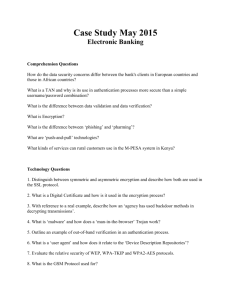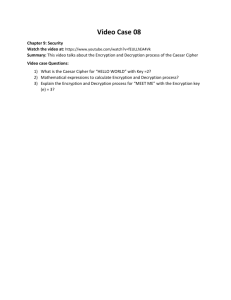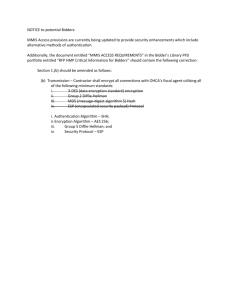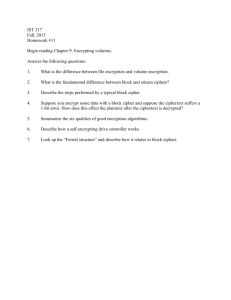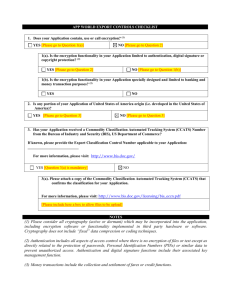Security
advertisement
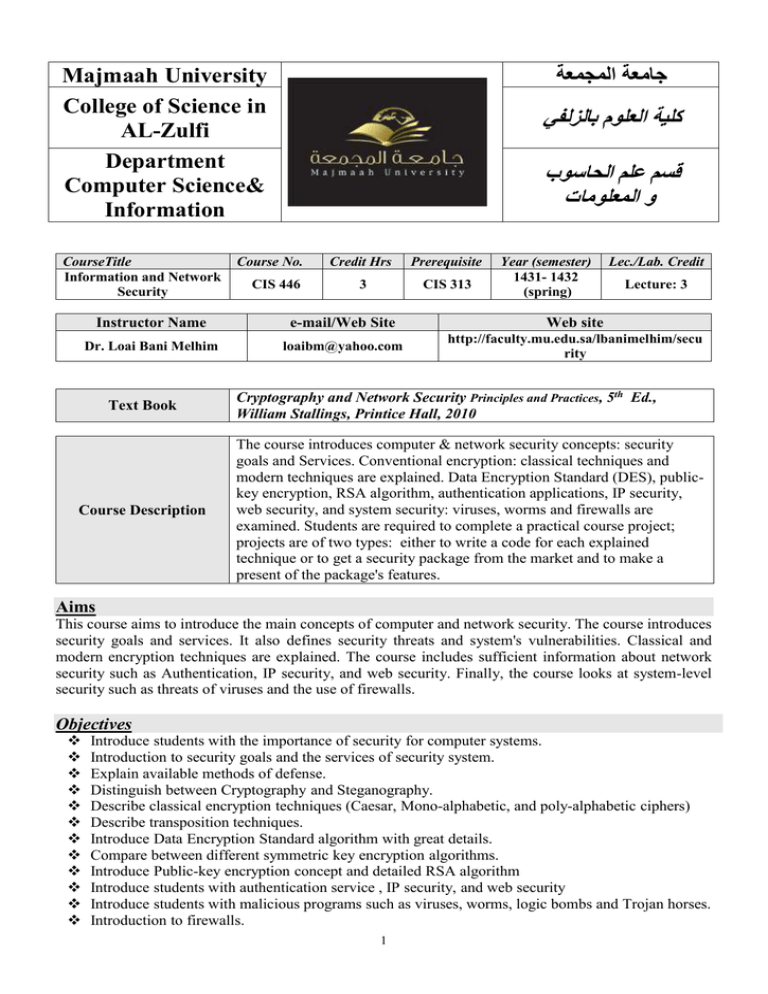
جامعة المجمعة Majmaah University College of Science in AL-Zulfi Department Computer Science& Information CourseTitle Information and Network Security Instructor Name Dr. Loai Bani Melhim Text Book Course Description كلية العلوم بالزلفي قسم علم الحاسوب و المعلومات Course No. CIS 446 Credit Hrs Prerequisite 3 CIS 313 Year (semester) 1431- 1432 (spring) Lec./Lab. Credit Lecture: 3 e-mail/Web Site Web site loaibm@yahoo.com http://faculty.mu.edu.sa/lbanimelhim/secu rity Cryptography and Network Security Principles and Practices, 5th Ed., William Stallings, Printice Hall, 2010 The course introduces computer & network security concepts: security goals and Services. Conventional encryption: classical techniques and modern techniques are explained. Data Encryption Standard (DES), publickey encryption, RSA algorithm, authentication applications, IP security, web security, and system security: viruses, worms and firewalls are examined. Students are required to complete a practical course project; projects are of two types: either to write a code for each explained technique or to get a security package from the market and to make a present of the package's features. Aims This course aims to introduce the main concepts of computer and network security. The course introduces security goals and services. It also defines security threats and system's vulnerabilities. Classical and modern encryption techniques are explained. The course includes sufficient information about network security such as Authentication, IP security, and web security. Finally, the course looks at system-level security such as threats of viruses and the use of firewalls. Objectives Introduce students with the importance of security for computer systems. Introduction to security goals and the services of security system. Explain available methods of defense. Distinguish between Cryptography and Steganography. Describe classical encryption techniques (Caesar, Mono-alphabetic, and poly-alphabetic ciphers) Describe transposition techniques. Introduce Data Encryption Standard algorithm with great details. Compare between different symmetric key encryption algorithms. Introduce Public-key encryption concept and detailed RSA algorithm Introduce students with authentication service , IP security, and web security Introduce students with malicious programs such as viruses, worms, logic bombs and Trojan horses. Introduction to firewalls. 1 Course Contents : Week 1, 2 3, 4 5 6 7 8 9 10 11 12 13 14 15 16 Topics Introduction Classical Encryption Techniques Block Cipher and Data Encryption Standard Advanced Encryption Standard Contemporary Symmetric Ciphers Confidentiality using symmetric encryption Publick-key encryption and RSA Message Authenication and Hash Functions Digital Signatures and Authentication Protocols Network Security Practice Network Security Practice System Security Projects Discussion Topic Details Security Threats, vulnerabilities, and Attacks, security mechanisms, security goals and services, model for network security, methods of defense Conventional encryption principles, Cryptography, Steganography, Substitution Techniques, Transposition Techniques, Rotor Machines. Simplified DES, Block Cipher Principles, The Data Encryption Standard. Evaluation Criteria for AES, The AES Cipher Reference Ch. 1 Ch. 2 Ch. 3 Ch. 5 First Exam IDEA, Blowfish, RC5, CAST-128 Ch. 6 Placement of encryption function, Traffic confidentiality, Key distribution, random number generation. Ch. 7 Discussion of Progress report Principles of Public–key Cryptosystems, The RSA Algorithm Ch. 9 Authentication Requirements, Authentication Functions, Hash Functions. Second Exam Digital Signatures, Authentication Protocols, Digital Signature Standard Authentication Applications, Electronic Mail Security, IP Security, Web Security and Auditing Intruders, Malicious Software, Firewalls. Group Presentation and Discussion Each group is given 10-15 minutes to present and discuss its project Final Exam 2 Ch. 11 Ch. 13 Ch. 14, 15 Ch. 16, 17 Ch. 18, 19, 20 Assign. Assesment and Grade Distribution Assesment I.Group Work Project Presentation & Discusion II. Individual Work Attendance, Participation, and Home works Quizzes First Exam Second Exam A Comprehensive Final Examination Points Total 10% 7% 3% 85% Chapter Homeworks, Discsstions, Presentations UnAnnounced Short quizes Multiple Choice Questions worth 25% of Grade. Essay Questions worth 75% of grade. Multiple choice questions worth 25% of grade. Essay questions worth 75% of grade. Multiple Choice Questions worth 25% of Grade. Essay Questions worth 75% of grade. TOTAL Short 5% exam exam 15% exam exam 20% exam exam 50% 100% References: [1] [2] [3] William Stallings. Cryptography and Network Security: Principles and Practices. Prentice Hall, (3rd Ed. 2003), (4th Ed. 2005), (5th Ed. 2010). Charles P. Pfleeger and Shari L. Pfleeger . Security in Computing. Prentice Hall, (3rd Ed. 2003), (4th Ed. 2006). Lecture's notes. COURSE POLICIES The University Regulations on Academic Dishonesty will be strictly enforced! Please check the University Statement on plagiarism. Make-up Exams: Only students with valid excuses are allwed to have make up exams. All excuses must be signed by the Faculty Dean. Student has the responsibility to arrange with his/her instructor for an exam date before the occurrence of the next regular exam. All assignment and class work must be submitted at the specified due date. No late work will be accepted. Attendance policy will be stricktly enforeced (refer to student's Handbook). No make up for quizzes under any circumstance. 3
